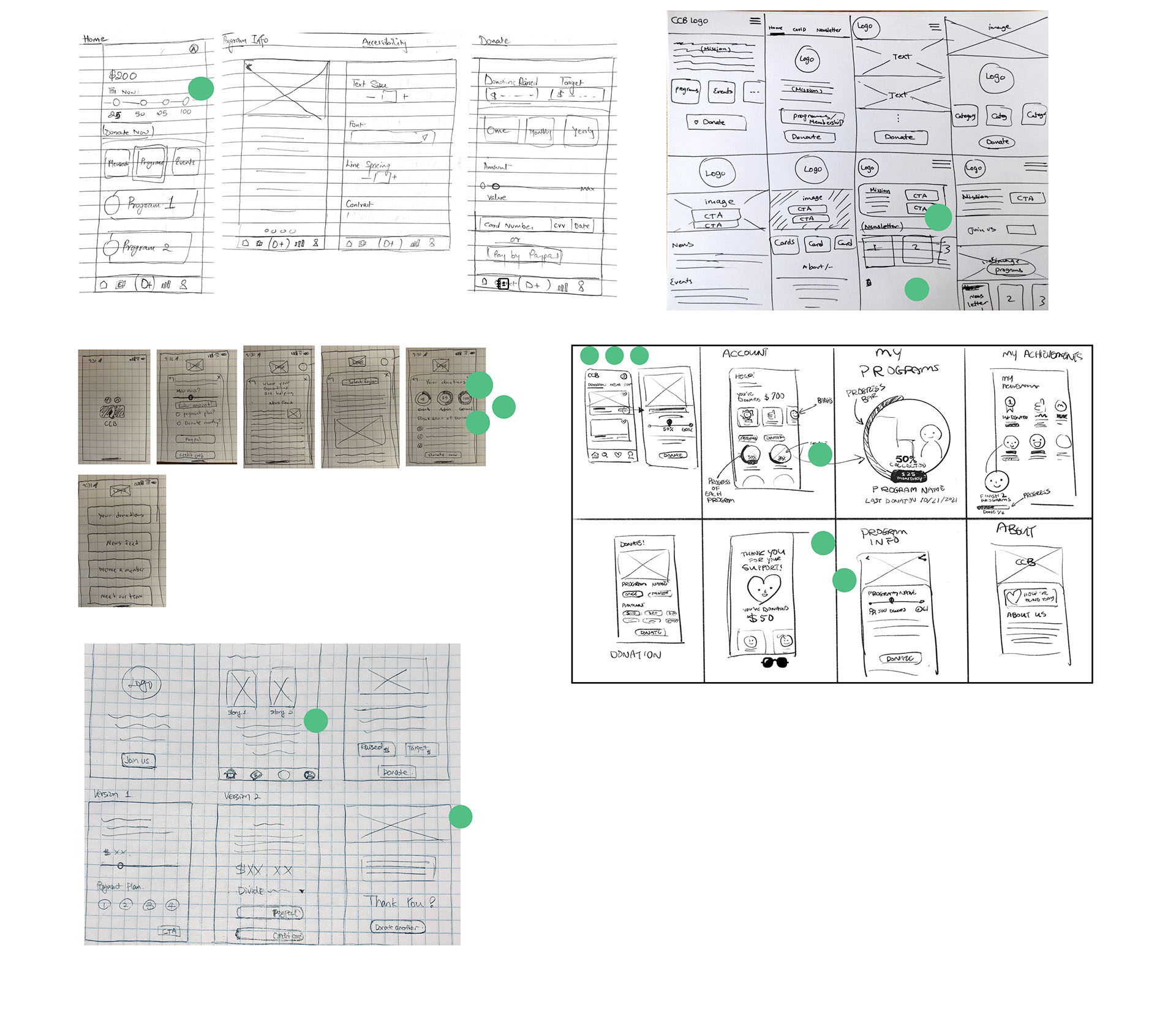Tasked to choose and design for an organization or a cause that improves the social good in a one week design sprint, our team focused on designing for the Canadian Council of the Blind (CCB). This organization does not have a strong online presence and unfortunately does not get the attention it deserves from the donors.


Start at the End - Goal Setting
By Auditing CCB's website & the donation experience on their website we made a list of goals for our sprint:
- Design a native mobile experience to encourage frequent donations & to structure their content information
- Create a user-friendly task flow for users who would like to donate
- Emphasize the impact the donations make to inspire donors
- Accessible design for visually impaired
ULTIMATE GOAL: To increase the donations to the CCB by improving the donation experience
Sprint Questions
What questions do you want to answer? To meet your goals, what has to be true?
Imagine you’ve traveled into the future, and the project was not successful. What caused it to fail?
Turn potential problems into questions.
What are the biggest unknowns? What is uncertain?

Mapping
To make a rough draft of how we will reach our long-term goal with our sprint questions in mind, we mapped the online donation experience map at CCB. In this map, it matters that we highlight different program options and financial breakdowns, so that donors can pick the impact they would like to make and with the breakdown see how their donation is helping the cause.
“There’s no better way to understand the hopes, desires, and aspirations of those you’re designing for than by talking to them directly.” - David Kelley, IDEO
Ask the Experts
Although we did not have access to CCB users to talk to them about their donation experiences with CCB, the group parted and interviewed 7 users who make donations on a regular basis or support charities. The interviews helped the team understand the goals, motivations, behaviors, and pain points donors face in the process of donating or supporting charities. To keep our users in mind and humanize our design decisions we made our persona using the data we gathered.
Meet Sarah Owen!

Take HMW notes, Organize & Vote!
After studying our users well enough to understand what they need most to have a good donation experience, we each wrote down a lot of HMWs on virtual sticky papers, organized them into themes, and voted with dots to choose the best target area for our design challenge.
Target Selection on the Map
With our most voted HMWs placed on the corresponding areas of our map, we are looking at a specific step in the story where will focus our solution on. Then with our sprint questions and the long-term goal in mind, we picked a target for our design sprint.
HOW MIGHT WE...?
Inform donors of the impact their donations make so that they are encouraged to donate?

Tuesday - Ideating & Skteching
In order to gather inspiration for our solution and ideate, we started our Tuesday morning with a competitor analysis, investigating other charities and foundations. In our investigation, we particularly focused on the donation flow, on how the donors are informed about the impact their donations are making, and also on how the foundations encourage donors to donate more. We chose to study Sickkids, the CNIB (Canadian National Institute for the Blind), The Obama Foundation, and some other charities.
After gathering inspiration and taking notes, the team did their sketches in the rapid crazy 8 activity. Then each person gave a short demo of their ideas and everyone voted for their favorite ideas with 3 dots.
We moved to solution sketches after that and voted for the solution ideas which were more detailed.
The voting processes and decision-making were done on Wednesday.



Wednesday - Decide
On Wednesday we voted and decided on the sketches using heatmaps, speed critiquing and straw poll and made a storyboard of the decided solution.
Thursday - Prototype
On Thursday we translated the sketches to the wireframes and prototyped them.
Friday - Test
On Friday we conducted a usability testing for the prototype with 4 different users and made a prioritization table to implement the changes for an improved prototype.
Final Prototype - The Solution
In the final prototype we implemented the iterations from the usability testing. With our solution, we solved the challenge of designing for social good and highlighting CCB & its programs for the users.
- Using our solution, users will feel more involved in supporting their preferred causes by seeing the impact they make with each donation.
- Including the progress donut chart for each program will also clearly show users how much money is raised for each program and goal, which is another psychological model that helps with raising donations.
- The financial transparent breakdown of the donations will give the users a better idea of how their donations help.
- will Also, users will get inspired by the stories and newsletters in the homepage of the CCB's app and by gaining virtual badges they will be rewarded for supporting CCB.
Design Sprint Takeaways
I'd like to share my final thoughts and key learnings from this amazing experience with this great team of UX Designers:
- Collaboration and role-assignment is key for acheiving results in a quick process like a design sprint.
- Design sprint is a great way to build and test solutions and save a lot of time and money before fully investing on an idea.
- Having different designers and people in the room, helps with building more innovative and viable solutions.

Selected Works

Employee approval of punchesProduct Design case study - Mobile & Web | end to end

Earnings TransparencyProduct Design case study - complex to simple



